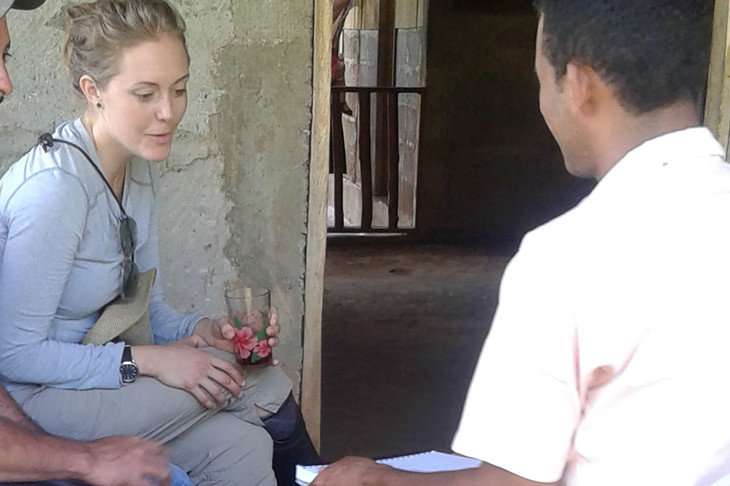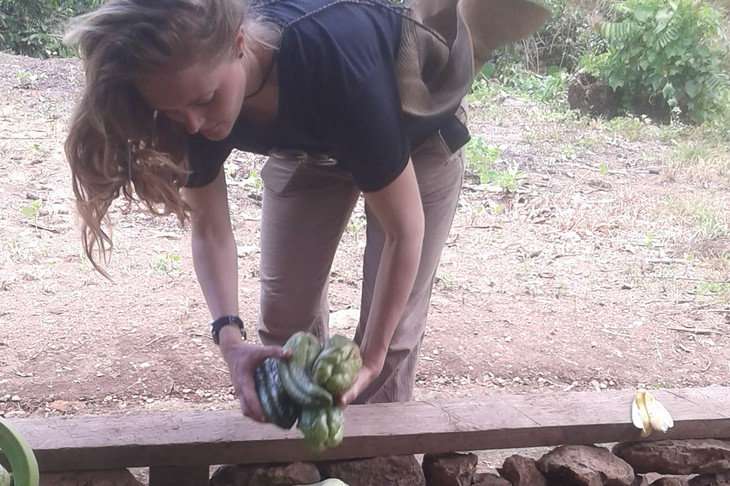Cultivating the connections between people and their environment

As the recipient of a National Science Foundation Graduate Research Fellowship, geography graduate student Megan Baumann has been spending the last few summers in Nicaragua learning from farmers how they manage their land and crops.
Although small farmers produce more than 80 percent of the world's food supply, they are among the most food insecure, according to the Food and Agriculture Organization of the United Nations. For one reason, small farmers devote their best fields and prime growing seasons to cash crops such as cocoa, coffee or bananas, and use less productive fields and growing times for their own foods such as beans or squash.
Through a seed intervention program, organized by Bioversity International, a global research-for-development organization, Nicaraguan farmers received different varieties of bean seeds bred for the growing conditions of the country. Farmers were also encouraged to grow more than one variety, as a kind of indemnity against loss due to insects or climate change. Baumann met with farmers to learn how they managed the new beans within their diversified cropping systems.
"Farmers make decisions based on detailed knowledge of their landscapes. In the region I visited, they gave special attention to management of slope and soil moisture, two components that often interact. For example, farmers often place bean crops on the steepest slopes to promote rainwater drainage; this prevents fungal diseases and promotes quicker drying of bean pods later in the season. I hope my research can contribute to organizations' implementation of seed programs to build on farmers' already complex landscape knowledge."
To meet and gain the trust of farmers, Baumann worked with women employed by local coffee cooperatives, who also facilitated local farmer field schools. "The women accompanied me to interviews and introduced me to the farmers and their families. It was also really important for me to frame my purpose as to learn from the farmers; I was not there to teach them anything. They are the experts within their fields."

Prior to coming to Penn State, Baumann's life and work experiences seemed to be leading her to this research project. She studied Spanish in high school, and as an undergraduate at Loyola University Chicago, she completed a double major in sociology and history and a minor in Spanish. Her proficiency was strengthened during study abroad and travel in Spanish-speaking countries. "I have used Spanish in all my jobs and research," she said.
In the Chicago area, as a student volunteer and summer intern, Baumann worked with immigrant advocacy groups: "I prepared Central American immigrants for their citizenship exams, working with them on their English and their familiarity with the U.S. Constitution."
That led to her work as a paralegal, specializing in political asylum cases, at the National Immigrant Justice Center in Chicago. "During that time, I was researching schools of international law and master's degrees in diplomacy, but the programs lacked the integrative approach I desired to understand and work to solve the complex problems I heard from asylum seekers in my office," she said.
In 2010, Baumann left the center. "I turned toward local, more concretely direct work: growing vegetables for and with residents of Chicago without access to fresh produce," Baumann said. "I was academically interested in food systems and environmental justice, and also loved the work of farming, the growing and labor. So I went to a technical program in sustainable urban horticulture, graduating in 2012, and then worked on farms for the next three years." She completed an internship at City Farm Chicago, then ran a small educational and production farm for the Chicago Botanic Garden Windy City Harvest Program.
The farm also supported STEM-focused summer jobs and learning opportunities for 30 low-income high school students. "We encouraged students to be observers of nutrient and hydrologic cycles, soil composition, and plant biology," said Baumann. "Our produce sold at affordable prices within surrounding neighborhoods as one part in the fight against high obesity rates and lack of access to good food. The goal of farm work was to create an environment for engaged learning and to support the well-being of the neighborhood."
What's next for Baumann? "I am excited by the opportunities afforded to me by receiving the GRFP," she said. "I am already enjoying the process of my dissertation-proposal writing and look forward to field research next year. We have such a richness in knowledge, social engagement and mutual support among faculty and graduate students in our department. I am really thrilled to be developing as a scholar here. In addition to research and writing, I really love teaching and I look forward to being faculty in a university or liberal arts college after finishing my Ph.D."
Provided by Pennsylvania State University



















